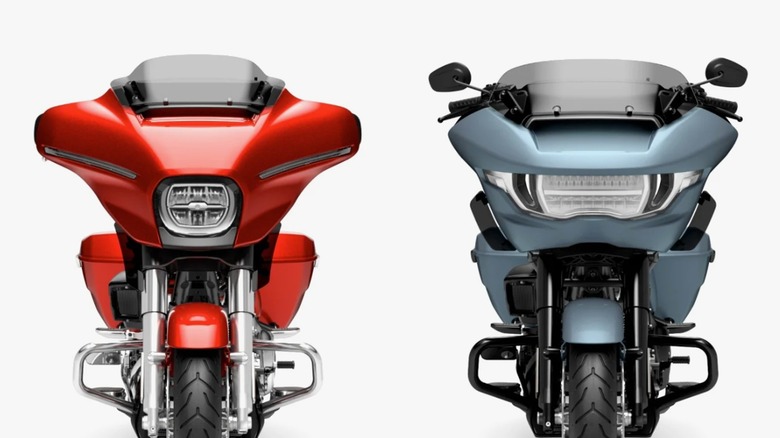2024 Harley-Davidson Street Glide Vs. Road Glide: What Are The Differences?
Every year brings a vast assortment of new models of just about anything you can think of from just as many brands — including motorcycle manufacturers like Harley-Davidson. Though sometimes, this can result in confusingly similar releases that may leave people scratching their heads as to what makes one better, worse, or just different than the other.
So to answer the question in the headline for this article, let's take a look at the 2024 Harley-Davidson Street Glide and its sibling, the 2024 Road Glide. At first glance there's not a whole lot setting the two apart. Even rapidly switching back-and-forth between the official photos of the bikes in profile doesn't offer much help — it just looks like the front section and handlebars are shaped differently. They also have a couple of different color options.
With all of that said there are indeed a few things that make the Street Glide versus Road Glide question worth asking. Just know that most of the differences are going to come down to personal preference.
Subtle differences between the Street Glide and Road Glide
In a very simplistic sense, the Harley-Davidson Street Glide and Road Glide are indeed almost the exact same bike — but with a couple of cosmetic differences. However, there are some minor deviations between the two that don't necessarily make one superior to the other but are still worth considering.
A ½-inch seat height difference means the 26.6-inch Road Glide might be a bit more comfortable for riders with longer legs when compared to the 26.1-inch height of the Street Glide. Similarly, the ground clearance on the Street Glide is a bit lower than the Road Glide — 5.5-inches compared to 5.7-inches, respectively. It's only a 0.2-inch discrepancy, but lower clearance means more ride stability (due to a lower center of gravity). Though it also makes speed bumps and curbs more of a problem.
There's also a noted difference between the trail of both bikes, with the Street Glide measuring 6.7-inches while the Road Glide comes in at 6.8-inches. A longer trail generally makes a bike more stable, but having a shorter trail makes it easier to turn. That 0.1-inch isn't likely to make or break either bike's performance, but again, it's something to keep in mind.
The biggest difference between the Street Glide and Road Glide
What really sets the Street Glide and Road Glide apart, by Harley-Davidson's own admission, is the front fairing. In other words, the aerodynamic shell in front of the handlebars at the front of the bike is shaped differently. There's a touch more to it than that, but those are the broad strokes. Aside from the obvious cosmetics, the fairing on the Road Glide sits a little farther forward, which could equate to a little extra comfort (or at least a less awkward and cramped feeling) for taller riders — not unlike the slightly taller seat height.
But by far the biggest deciding factor is the way the fairings are attached to the bike. On the Street Glide, it's connected directly to the forks (the two parts of the frame that connect to the front wheel). This means that steering will cause the fairing to move along with the handlebars. Conversely, the Road Glide's fairing is attached to the frame itself rather than the forks, so it'll keep facing the front of the bike no matter how much the handlebars turn.
This is still mostly a preference thing, like most everything else we've covered already; however, there is something important to note about the difference between a frame- and fork-mounted fairing, namely that frame-mounted fairings tend to handle wind better than fork-mounted ones. It's something that mostly comes into play at high speeds or in windy riding conditions, so if stability is very important to you, the Road Glide might be the better option.


